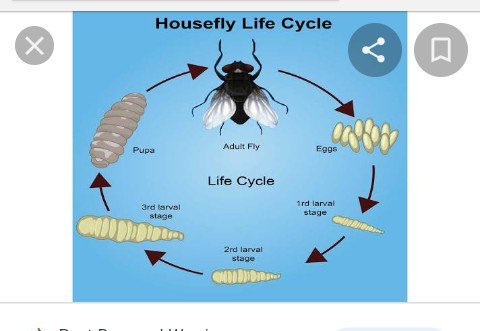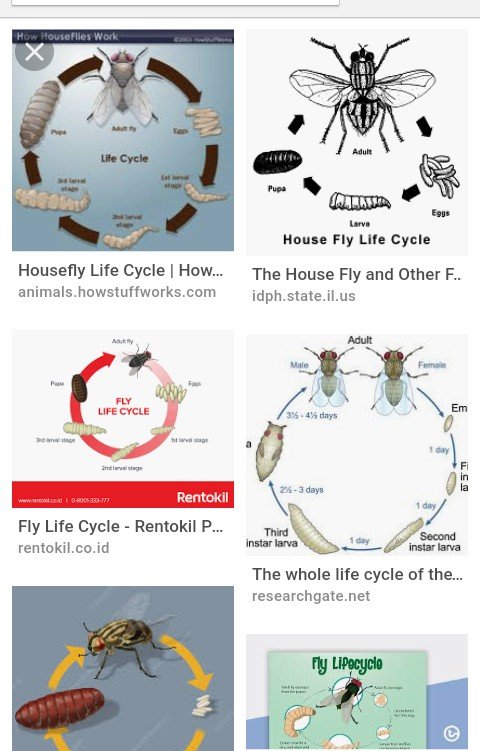MY FIRST CONTEST ON LIFE CYCLE OF HOUSEFLY
common name: house fly
scientific name: Musca domestica Linnaeus (Insecta: Diptera: Muscidae)
Introduction - Distribution - Description and Life Cycle - Damage and Medical Importance - Economic Threshold - Management - Selected References
Introduction (Back to Top)
The house fly, Musca domestica Linnaeus, is a well-known cosmopolitan pest of both farm and home. This species is always found in association with humans or the activities of humans. It is the most common species found on hog and poultry farms, horse stables and ranches. Not only are house flies a nuisance, but they can also transport disease-causing organisms. Excessive fly populations are not only an irritant to farm workers but, when there are nearby human habitations, a public health problem could occur.
Adult house fly, Musca domestica Linnaeus.
Figure 1. Adult house fly, Musca domestica Linnaeus. Photograph by Jim Kalisch, University of Nebraska-Lincoln.
Distribution
This common fly originated on the steppes of central Asia, but now occurs on all inhabited continents, in all climates from tropical to temperate, and in a variety of environments ranging from rural to urban. It is commonly associated with animal feces, but has adapted well to feeding on garbage, so it is abundant almost anywhere people live.
Life Cycle and Description (Back to Top)
The house fly has a complete metamorphosis with distinct egg, larval or maggot, pupal and adult stages. The house fly overwinters in either the larval or pupal stage under manure piles or in other protected locations. Warm summer conditions are generally optimum for the development of the house fly, and it can complete its life cycle in as little as seven to ten days. However, under suboptimal conditions the life cycle may require up to two months. As many as 10 to 12 generations may occur annually in temperate regions, while more than 20 generations may occur in subtropical and tropical regions.
Life cycle of the house fly, Musca domestica Linnaeus. Clockwise from upper left: eggs, larva, pupa, adult.
Egg: The white egg, about 1.2 mm in length, is laid singly but eggs are piled in small groups. Each female fly can lay up to 500 eggs in several batches of 75 to 150 eggs over a three to four day period. The number of eggs produced is a function of female size which, itself, is principally a result of larval nutrition. Maximum egg production occurs at intermediate temperatures, 25 to 30°C. Often, several flies will deposit their eggs in close proximity, leading to large masses of larvae and pupae. Eggs must remain moist or they will not hatch.
Adult and eggs of the house fly, Musca domestica Linnaeus.
Figure 3. Adult and eggs of the house fly, Musca domestica Linnaeus. Photograph by Jerry F. Butler, University of Florida.
Larva: Early instar larvae are 3 to 9 mm long, typical creamy whitish in color, cylindrical but tapering toward the head. The head contains one pair of dark hooks. The posterior spiracles are slightly raised and the spiracular openings are sinuous slits which are completely surrounded by an oval black border. The legless maggot emerges from the egg in warm weather within eight to 20 hours. Maggots immediately begin feeding on and developing in the material in which the egg was laid.
The larva goes through three instars and a full-grown maggot, 7 to 12 mm long, has a greasy, cream-colored appearance. High-moisture manure favors the survival of the house fly larva. The optimal temperature for larval development is 35 to 38°C, though larval survival is greatest at 17 to 32°C. Larvae complete their development in four to 13 days at optimal temperatures, but require 14 to 30 days at temperatures of 12 to 17°C.
Nutrient-rich substrates such as animal manure provide an excellent developmental substrate. Very little manure is needed for larval development, and sand or soil containing small amounts of degraded manure allows for successful belowground development. When the maggot is full-grown, it can crawl up to 50 feet to a dry, cool place near breeding material and transform to the pupal stage.
Pupa: The pupal stage, about 8 mm long, is passed in a pupal case formed from the last larval skin which varies in color from yellow, red, brown, to black as the pupa ages. The shape of the pupa is quite different from the larva, being bluntly rounded at both ends. Pupae complete their development in two to six days at 32 to 37°C, but require 17 to 27 days at about 14°C). The emerging fly escapes from the pupal case through the use of an alternately swelling and shrinking sac, called the ptilinum, on the front of its head which it uses like a pneumatic hammer to break through the case.
Prepupa and sequence of puparia by age for the house fly, Musca domestica Linnaeus.
Figure 4. Prepupa and sequence of puparia by age for the house fly, Musca domestica Linnaeus. Photograph by Jim Kalisch, University of Nebraska-Lincoln.
Adult: The house fly is 6 to 7 mm long, with the female usually larger than the male. The female can be distinguished from the male by the relatively wide space between the eyes (in males, the eyes almost touch). The head of the adult fly has reddish-eyes and sponging mouthparts. The thorax bears four narrow black stripes and there is a sharp upward bend in the fourth longitudinal wing vein. The abdomen is gray or yellowish with dark midline and irregular dark markings on the sides. The underside of the male is yellowish.
Adult house fly, Musca domestica Linnaeus.
Figure 5. Adult house fly, Musca domestica Linnaeus. Photograph by Matt Aubuchon, University of Florida.
Lateral view of the head of an adult house fly, Musca domestica Linnaeus.

